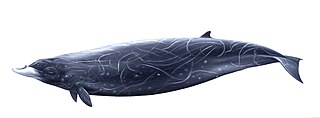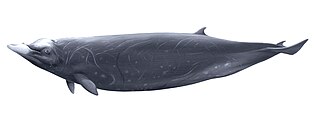Beaked whales are a family of cetaceans noted as being one of the least-known groups of mammals because of their deep-sea habitat, reclusive behavior and apparent low abundance. Only three or four of the 24 existing species are reasonably well-known. Baird's beaked whales and Cuvier's beaked whales were subject to commercial exploitation, off the coast of Japan, while the northern bottlenose whale was extensively hunted in the northern part of the North Atlantic in the late 19th and early 20th centuries.

Andrews' beaked whale, sometimes known as the deep-crest beaked whale or splay-toothed whale, is one of the least known members of a poorly known genus. The species has never been observed in the wild, and is known only from specimens washed up on beaches.

Mesoplodont whales are 16 species of toothed whale in the genus Mesoplodon, making it the largest genus in the cetacean order. Two species were described as recently as 1991 and 2002, and marine biologists predict the discovery of more species in the future. A new species was described in 2021. They are the most poorly known group of large mammals. The generic name "mesoplodon" comes from the Greek meso- (middle) - hopla (arms) - odon (teeth), and may be translated as 'armed with a tooth in the centre of the jaw'.

Sowerby's beaked whale, also known as the North Atlantic or North Sea beaked whale, is a species of toothed whale. It was the first mesoplodont whale to be described. James Sowerby, an English naturalist and artist, first described the species in 1804 from a skull obtained from a male that had stranded in the Moray Firth, Scotland, in 1800. He named it bidens, which derives from the two teeth present in the jaw, now known to be a very common feature among the genus.

Hubbs' beaked whale was initially thought to be an Andrews' beaked whale when discovered by ichthyologist Carl Hubbs; however, it was named in his honor when it was discovered to be a new species. This species has the typical dentition found in the genus, but its main outstanding features are a white "cap" on the head and very extensive scarring. The species is known from 31 strandings, a few at-sea sightings, and observations of two stranded whales that were kept in captivity for 16–25 days.

Blainville's beaked whale, or the dense-beaked whale, is believed to be the widest ranging mesoplodont whale. The French zoologist Henri de Blainville first described the species in 1817 from a small piece of jaw — the heaviest bone he had ever come across — which resulted in the name densirostris. Off the northeastern Bahamas, the animals are particularly well documented, and a photo identification project started sometime after 2002.

Gervais's beaked whale, sometimes known as the Antillean beaked whale, Gulf Stream beaked whale, or European beaked whale is the most frequently stranding type of mesoplodont whale off the coast of North America. It has also stranded off South America and Africa.

The ginkgo-toothed beaked whale is a poorly known species of whale even for a beaked whale, and was named for the unusual shape of its dual teeth. It is a fairly typical-looking species, but is notable for the males not having any scarring.

Gray's beaked whale, sometimes known as Haast's beaked whale, the scamperdown whale, or the southern beaked whale, is one of the better-known members of the genus Mesoplodon. This species is fairly gregarious and strands relatively frequently for a beaked whale. In the Māori language, this species is called hakurā or iheihe.

Hector's beaked whale, is a small mesoplodont living in the Southern Hemisphere. This whale is named after Sir James Hector, a founder of the colonial museum in Wellington, New Zealand. The species has rarely been seen in the wild.

The strap-toothed beaked whale, also known as Layard's beaked whale, is one of the largest members of the mesoplodont genus, growing to 6.2 m (20 ft) in length and reaching up to 1,300 kg (2,900 lb). The common and scientific name was given in honor of Edgar Leopold Layard, the curator of the South African Museum, who prepared drawings of a skull and sent them to the British taxonomist John Edward Gray, who described the species in 1865.

True's beaked whale is a medium-sized whale in the genus Mesoplodon. It is native to the northern Atlantic Ocean. The common name is in reference to Frederick W. True, a curator at the United States National Museum.

The tropical bottlenose whale, also known as the Indo-Pacific beaked whale or Longman's beaked whale, was considered to be the world's rarest cetacean until recently, but the spade-toothed whale now holds that position. As of 2010, the species is now known from nearly a dozen strandings and over 65 sightings. This is the only species in the genus Indopacetus.

Stejneger's beaked whale, also known as the Bering Sea beaked whale or the saber-toothed whale, is a relatively unknown member of the genus Mesoplodon inhabiting the North Pacific Ocean. Leonhard Hess Stejneger collected the type specimen on Bering Island in 1883, from which Frederick W. True provided the species' description in 1885. In 1904, the first complete skull was collected, which confirmed the species' validity. The most noteworthy characteristic of the males is the very large, saber-like teeth, hence the name.

Perrin's beaked whale is part of the toothed whale suborder and is one of over 90 known cetaceans in existence today. Beaked whales are part of the family Ziphiidae, which are the second most diverse group out of all marine mammals with over 20 species currently recognized. Although diverse, little is understood about these timid, deep divers that can dive for up to two hours. The whales are partially named after their beak shaped jaw, which extends from their small head. The genus name Mesoplodon comes from the Greek meanings of meso- (middle), - hopla (arms), - odon (teeth), and may be translated as 'armed with a tooth in the center of the jaw'.

The spade-toothed whale is a very little-known species, the rarest species of beaked whale.
Deraniyagala's beaked whale is a species of mesoplodont whale closely related to the ginkgo-toothed beaked whale.

Ramari's beaked whale is a medium size whale in the genus Mesoplodon. It is found in cool waters of the Southern Hemisphere. The species name, eueu, comes from the Khwedam word meaning 'big fish', as most of the strandings of these whales come from Khoisan territories in South Africa. The common name honours Māori whale expert Ramari Stewart.
Cetaceans form an infra-order of marine mammals. In 2020, approximately 86 species of cetaceans had been identified worldwide. Among these species, at least 35 have been sighted in the wider Caribbean region with very widespread distribution and density variations between areas. Caribbean waters are a preferred breeding site for several species of mysticeti, who live further north the rest of the year. The tucuxi and the boto live at the southern periphery of the Caribbean region in the freshwaters of the Amazon river and surrounding drainage basins.



















